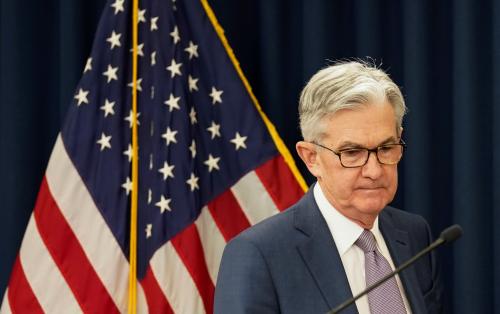This report is part of the Series on Financial Markets and Regulation and was produced by the Brookings Center on Regulation and Markets.
Since 1994, the Federal Reserve has launched—or, in many cases, been shoved into—an era of more open communication. Before 1994, the Fed would not even publish the results of its interest-rate decisions, leaving the news to percolate through market activity. Central bankers cultivated an aura of mystique, focused on opacity in communication. Fed Chairman Alan Greenspan nurtured this image with particular enthusiasm. “If I turn out to be particularly clear,” he famously said in 1988, “you’ve probably misunderstood what I said.”[1]
At the behest of Congress and nudged by other central banks’ practices, the Fed changed: not only does it now release the details of its decisions, the Fed holds a press conference after every such meeting, releases a Summary of Economic Projections that contains projections of key economic indicators from the participants on the Federal Open Market Committee, makes FOMC members available for interviews with reporters, and engages in a variety of other once unheard-of mechanisms to ensure greater transparency and clarity. When the Fed recently reevaluated its monetary policy framework, it did so only after fourteen meetings convened as part of a campaign the central bank called “Fed Listens.” These changes, once called a “quiet revolution” by former central banker and prominent advocate for greater Fed transparency Alan Blinder, have become rather noisy.[2]
In the Trump era, conversations about the Fed became noisier, still. On April 16, 2018, Donald Trump tweeted his first critique of the Federal Reserve’s monetary policy as President: that, while other countries are “playing the Currency Devaluation game,” the U.S. “keeps raising interest rates,” which is “Not acceptable!”[3]. Dozens of critical tweets—many directly aimed personally at Fed Chair Jerome Powell—would follow. “As usual, Powell let us down,” Trump tweeted a few months later.[4] Powell made “TWO enormous mistakes,”[5] he is “clueless,”[6] exhibits a “horrendous lack of vision.”[7] By August 2019, Trump asked “who is our bigger enemy, Jay Powell or Chairman Xi?”[8]
Many viewed these tweets as an affront to the norms of central bank independence, an effort to politicize the work of the Fed for partisan political ends. But did these critical tweets from the President matter?
This paper seeks to connect these two discussions—about the Fed’s efforts to increase its communications and the president’s use of Twitter to attack the Fed’s monetary policy decisions—by focusing on how the Fed uses Twitter, a relatively new and surprisingly powerful medium on which officials communicate directly with citizens, reporters break news, and ordinary people across the globe engage in direct conversation with each other. While other scholars have assessed the impact of Twitter on interest rates,[9] and central bank communications have become a growing area of other scholarly concern,[10] this is the first effort of which we are aware to document how the Fed uses Twitter and how Twitter users—especially President Trump—engage the Fed.
The effort produces three key findings. First, we identify patterns of usage among Federal Reserve entities and compare these patterns to those at other agencies and central banks. We learn that the Fed’s Reserve Banks are more prolific users of Twitter than the Fed’s Board of Governors (Board), but the Board has higher engagement with Twitter users. The Fed, as a whole, is also an average Twitter user compared to other central banks, more active than other independent agencies, but less than executive departments.
Second, Twitter users don’t generally like the Fed. That is, although Twitter users discuss the Fed about as much as other major federal regulatory agencies, that discussion is likely more negative (using the Twitter “ratio” as a loose proxy for negativity).
And third, President Trump’s Twitter campaign against the Fed has been good for the President’s Twitter account and bad for the Federal Reserve. The President’s tweets amplify discussions about the Fed on Twitter. More importantly, President Trump’s Fed tweets generate a larger and more favorable response from Twitter users than do his other tweets.
The paper concludes with a discussion on the implications of these findings, including ways that the Fed can use Twitter more effectively to keep pace with its efforts to enhance its communications with the public.
Read the full paper here.
The authors did not receive financial support from any firm or person for this article or from any firm or person with a financial or political interest in this article. Neither is currently an officer, director, or board member of any organization with an interest in this article.
The Brookings Institution is committed to quality, independence, and impact.
We are supported by a diverse array of funders. In line with our values and policies, each Brookings publication represents the sole views of its author(s).









